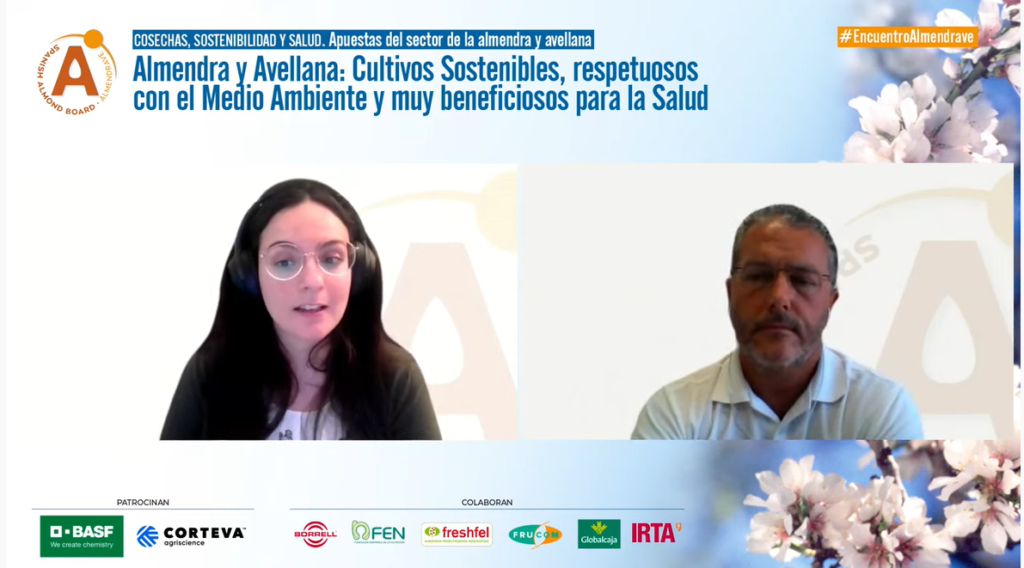The Agrupación de Exportadores de Almendra y Avellana de España (Spanish Almond Board, SAB-Almendrave) held the sixth almond and hazelnut gathering, entitled this year round “Crops, sustainability and health: Almond and hazelnut sector commitments” – a virtual event that saw the participation of Importaco Group, which contributed its experience in the field of sustainable transformation of almond and hazelnut crops.
This event saw the participation of national and international experts who analysed the new developments and forecasts related to the cultivation of these crops around the world, with a focus on sustainability, environmental policies and the health benefits of almonds and hazelnuts.
During the opening speech, the president of SAB-Almendrave, Pere Ferré, highlighted that the cultivation of almond trees has grown by 36% in the last six years, for a total of 718,540 hectares. “What is more important is that most of the new plantations are on irrigable land, reaching 118,000 hectares from the previous 46,000”.
Later, several international experts discussed the outlook for the new crops. Richard Waycott, president and CEO of the Almond Board of California, stated that they are experiencing a drought that “will undoubtedly affect production costs in our valley, since more money must be paid for the use of the water”.
And in this regard, Ross Skinner, CEO of the Almond Board of Australia, estimated that this year they will reach 58,000 crop hectares and 123,000 tons of almonds, expecting their production potential to reach 180,000 tons by 2025.
On the other hand, the production potential of Spain is expected to amount to 180,000 tons by 2024.
The next block focused on sustainability, environment and health. Gaspar Alapont, Importaco Group’s director of almond purchases in Spain, gave the opening talk titled “Almond and hazelnut: sustainable, eco-friendly crops that are highly beneficial to people’s health”.
During his talk, he explained that the priority for all stakeholders in the value chain is “to be compliant with today’s environmental policies from the field, through industries, to the customers – especially the end consumer”.
“The consumer is asking that we have more social responsibility in relation to the environment”, Gaspar claimed.

Gaspar Alapont insisted on “stressing the importance of maintaining global standards that facilitate transactions with stakeholders from different countries”. The goal is of each stakeholder in the value chain to “work under the same operational standards, such as Global GAP, IFS, BRC; in order to homogenise and guarantee a modulus operandi that allows customers to receive the product they paid for with all the assurances this implies”.
This was another of the critical issues discussed during the event. “Spanish almonds have been associated with this peculiarity in the past because bitter almonds would be mixed with conventional ones. Now, we are in a position where we can guarantee the absence of bitter almonds through a late flowering stage. This needs to be a standard that must be passed on to every country. To do this, we must work and raise awareness at the source working with the farmers”, Gaspar explained.
In addition, Gaspar also weighed in about the importance of jointly defining standard varieties in the sector: “As for global standards, with the arrival of major productions, we must understand the final product as a final variety or mixture that is perfectly defined, agreed upon and identified across the entire industry – from the farmer, all the way to the customer”.
On the other hand, José Manuel Ávila, general director of Fundación Española de la Nutrición (Spanish Nutrition Foundation), weighed in about the nutritional advantages of almonds and hazelnuts: “Sweet almond has a high fat content – especially monounsaturated fats; it is a source of vegetable proteins and, to a lesser extent, it contains carbohydrates. As for the hazelnut, 78% of its fat is monounsaturated. They are like small capsules of olive oil.
During this seminar, the results of the «Detection and Eradication of Bitter Almond» taskforce, led by SAB-Almendrave, were also informed, whose members include Importaco and SMEs, multinationals, national producer organisations, cooperatives and R&D centres.
Xavier Miarnau, IRTA horticultural crop specialist and technical coordinator of the Taskforce, highlighted that 25% of the surface monitored by the project, which can be extrapolated to 50% of the country’s surface, was at risk of having bitter almonds.
For her part, Isabel Bombal, general director of Rural Development, Innovation and Forestry Policy of the Ministry of Agriculture, Fishing and Food, stated that “this taskforce is an example of how a sector can innovate by integrating technological solutions throughout the entire chain”.
The closing event of this meeting saw the participation of María Angélica Mateo, head of the Fruit and Vegetable Department of the General Sub-Directorate of Fruit and Vegetables and Viticulture of the Ministry of Agriculture, who highlighted that Spain is the main producer and exporter of nuts in Europe and the second exporter worldwide, with exports valued at 700 million euros.
“The sector has made authentic efforts, focusing on traditional models, but also on intensive models where irrigable land is increasingly gaining importance. At the Ministry of Agriculture, Fishing and Food we consider that it is a key sector.
The event can be seen in its entirety in Almendrave’s YouTube channel.


CONOCE EL NUEVO HUB DE INSPIRACIÓN PARA PROFESIONALES DEL FOOD SERVICE Y LA INDUSTRIA ALIMENTARIA. TODA LA CREATIVIDAD Y LA INNOVACIÓN EN LA APLICACIÓN DE LOS FRUTOS SECOS.
SABER MÁS